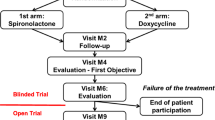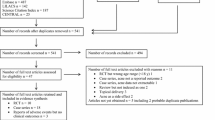Abstract
Background
Few studies have addressed anti-androgenic therapy using oral spironolactone for acne in Asians. Obtaining this race-specific information is important because Westerners and Asians respond differently to hormone therapy. This study aimed to examine the efficacy and safety of oral spironolactone used to treat acne in Asians.
Methods
Spironolactone (initial dose, 200 mg/day) was administered orally to 139 Japanese patients (116 females and 23 males) with acne. Serum laboratory data, including various hormones and electrolytes, were examined for 25 of the subjects.
Results
Most of the female patients who completed the 20-week regimen exhibited excellent improvement (evaluated by a photographic grading scale), although some discontinued treatment because of menstrual disturbances or other reasons. The treatment was less efficacious for the males than for the females, and because gynecomastia developed in three male patients, spironolactone treatment for males was stopped. Examination of the serum of 25 patients did not identify any toxicity associated with the treatment. Drug eruptions and edema in the lower extremities were each seen in three patients.
Conclusion
Oral spironolactone is effective and safe for the treatment of acne in Asian females, and can be a good option for severe, recurring, and widespread types of the condition.





Similar content being viewed by others
References
Allen BS, Smith JG Jr: Various parameters for grading acne vulgaris. Arch Dermatol 118:23–25, 1982
Carmina E, Stanczyk FZ, Matteri RK, Lobo RA: Serum androsterone conjugates differentiate between acne and hirsutism in hyperandrogenic women. Fertil Steril 55:872–876, 1991
Cooper AJ: Treatment of acne with isotretinoin: Recommendations based on Australian experience. Australian Roaccutane Advisory Board. Australas J Dermatol 44:97–105, 2003
Goulden V, Clark SM, Cunliffe WJ: Postadolescent acne: A review of clinical features. Br J Dermatol 136:66–70, 1997
Kasper P: Cyproterone acetate: A genotoxic carcinogen? Pharmacol Toxicol 88:223–231, 2001
Lucky AW, McGuire J, Rosenfield RL, Lucky PA, Rich BH: Plasma androgens in women with acne vulgaris. J Invest Dermatol 81:70–74, 1983
Masahashi T, Wu MC, Ohsawa M, Asai M, Ichikawa Y, Hanai K, Kikkawa H, Mizutani S, Narita O, Tomoda Y: Spironolactone therapy for hyperandrogenic anovulatory women: Clinical and endocrinological study. Nippon Sanka Fujinka Gakkai Zasshi 38:95–101, 1986
Messina M, Manieri C, Musso MC, Pastorino R: Oral and topical spironolactone therapies in skin androgenization. Panminerva Med 32:49–55, 1990
Muhlemann MF, Carter GD, Cream JJ, Wise P: Oral spironolactone: An effective treatment for acne vulgaris in women. Br J Dermatol 115:227–232, 1986
Ng PP, Goh CL: Treatment outcome of acne vulgaris with oral isotretinoin in 89 patients. Int J Dermatol 38:213–216, 1999
Parys BT, Hamid S, Thomson RG: Severe hepatocellular dysfunction following cyproterone acetate therapy. Br J Urol 67:312–313, 1991
Satoh T, Itoh S, Seki T, Itoh S, Nomura N, Yoshizawa I: On the inhibitory action of 29 drugs having side effect gynecomastia on estrogen production. J Steroid Biochem Mol Biol 82:209–216, 2002
Shaw JC: Low-dose adjunctive spironolactone in the treatment of acne in women: A retrospective analysis of 85 consecutively treated patients. J Am Acad Dermatol 43:498–502, 2000
Shaw JC, White LE: Long-term safety of spironolactone in acne: Results of an 8-year follow-up study. J Cutan Med Surg 6:541–545, 2002
Slayden SM, Moran C, Sams WM Jr, Boots LR, Azziz R: Hyperandrogenemia in patients presenting with acne. Fertil Steril 75:889–892, 2001
Takashima E, Iguchi K, Usui S, Yamamoto H, Hirano K: Metabolite profiles of flutamide-induced hepatic dysfunction. Biol Pharm Bull 26:1455–1460, 2003
Thiboutot D, Chen W: Update and future of hormonal therapy in acne. Dermatology 206:57–67, 2003
Vexiau P, Husson C, Chivot M, Brerault JL, Fiet J, Julien R, Villette JM, Hardy N, Cathelineau G: Androgen excess in women with acne alone compared with women with acne and/or hirsutism. J Invest Dermatol 94:279–283, 1990
Wysowski DK, Freiman JP, Tourtelot JB, Horton ML III: Fatal and nonfatal hepatotoxicity associated with flutamide. Ann Intern Med 118:860–864, 1993
Zouboulis CC, Martin JP: Update and future systemic acne treatment. Dermatology 206:37–53, 2003
Author information
Authors and Affiliations
Corresponding author
Rights and permissions
About this article
Cite this article
Sato, K., Matsumoto, D., Iizuka, F. et al. Anti-androgenic Therapy Using Oral Spironolactone for Acne Vulgaris in Asians. Aesth Plast Surg 30, 689–694 (2006). https://doi.org/10.1007/s00266-006-0081-0
Published:
Issue Date:
DOI: https://doi.org/10.1007/s00266-006-0081-0




